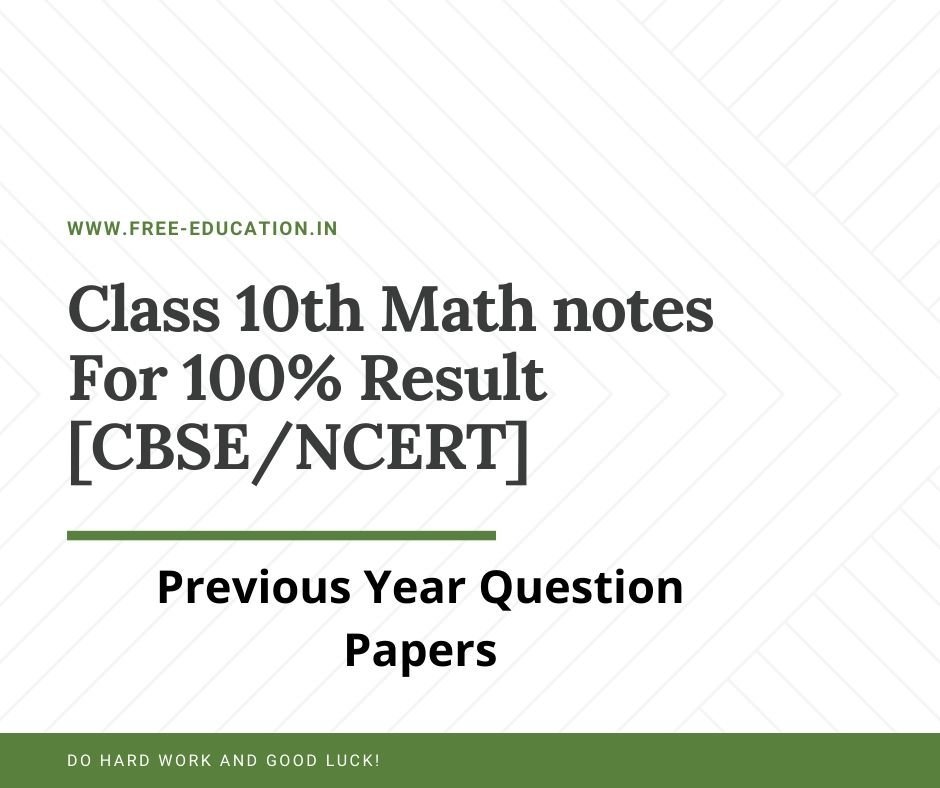www.free-education.in is a platform where you can get pdf notes from 6th to 12th class notes, General Knowledge post, Technical Courses, Engineering post, Career Guidelines , English Speaking Trick , How to crack interview and lots more.( Class 10th Maths Notes )
[CBSE/NCERT] Class 10th Math notes for students to get 100% result
CBSE class 10th Math notes provided by free-education.in (Wisdom Education Academy) have been consistently proved to be helpful for the revision of class Tenth students who aiming to get maximum marks. Math is undoubtedly is a core subject for students. Here We are providing all subject wise pdf notes to student for their help to get good marks in Math.
Download CBSE 2020-21 Math PDF notes given below by free-education.in to excel in the exam. www.free-education.in is a platform where you can get pdf notes from 6th to 12th class notes, General Knowledge post, Engineering post, Career Guidelines , English Speaking Trick , How to crack interview and lots more.
Class 10th Math Notes
Class 10th Math Syllabus
Find below the complete CBSE Class 10 Maths Syllabus 2020-2021:
CBSE Class 10 Mathematics Unit-Wise Weightage
| Units | Unit Name | Marks |
| I | NUMBER SYSTEMS | 06 |
| II | ALGEBRA | 20 |
| III | COORDINATE GEOMETRY | 06 |
| IV | GEOMETRY | 15 |
| V | TRIGONOMETRY | 12 |
| VI | MENSURATION | 10 |
| VII | STATISTICS & PROBABILITY | 11 |
| Total | 80 |
Download Class 10th math Syllabus pdf
CBSE Class 10 Mathematics Course Structure:
UNIT I: NUMBER SYSTEMS
1. Real Numbers (15 Periods)
Euclid’s division lemma, Fundamental Theorem of Arithmetic – statements after reviewing work done earlier and after illustrating and motivating through examples, Proofs of irrationality ofDecimal representation of rational numbers in terms of terminating/non-terminating recurring decimals.
UNIT II: ALGEBRA
1. Polynomials (7 Periods)
Zeros of a polynomial. Relationship between zeros and coefficients of quadratic polynomials. Statement and simple problems on division algorithm for polynomials with real coefficients.
2. Pair of Linear Equations in Two Variables (15 Periods)
Pair of linear equations in two variables and graphical method of their solution, consistency/inconsistency.
Algebraic conditions for number of solutions. Solution of a pair of linear equations in two variables algebraically – by substitution, by elimination and by cross multiplication method. Simple situational problems. Simple problems on equations reducible to linear equations.
3. Quadratic Equations (15 Periods)
Standard form of a quadratic equation ax2 + bx + c = 0, (a ≠ 0). Solutions of quadratic equations (only real roots) by factorization, and by using quadratic formula. Relationship between discriminant and nature of roots.
Situational problems based on quadratic equations related to day to day activities to be incorporated.
4. Arithmetic Progressions (8 Periods)
Motivation for studying Arithmetic Progression Derivation of the nth term and sum of the first n terms of an A.P. and their application in solving daily life problems.
UNIT III: COORDINATE GEOMETRY
1. Lines (In two-dimensions) (14 Periods)
Review: Concepts of coordinate geometry, graphs of linear equations. Distance formula. Section formula (internal division). Area of a triangle.
UNIT IV: GEOMETRY
1. Triangles (15 Periods)
Definitions, examples, counter examples of similar triangles.
1. (Prove) If a line is drawn parallel to one side of a triangle to intersect the other two sides in distinct points, the other two sides are divided in the same ratio.
2. (Motivate) If a line divides two sides of a triangle in the same ratio, the line is parallel to the third side.
3. (Motivate) If in two triangles, the corresponding angles are equal, their corresponding sides are proportional and the triangles are similar.
4. (Motivate) If the corresponding sides of two triangles are proportional, their corresponding angles are equal and the two triangles are similar.
5. (Motivate) If one angle of a triangle is equal to one angle of another triangle and the sides including these angles are proportional, the two triangles are similar.
6. (Motivate) If a perpendicular is drawn from the vertex of the right angle of a right triangle to the hypotenuse, the triangles on each side of the perpendicular are similar to the whole triangle and to each other.
7. (Prove) The ratio of the areas of two similar triangles is equal to the ratio of the squares of their corresponding sides.
8. (Prove) In a right triangle, the square on the hypotenuse is equal to the sum of the squares on the other two sides.
9. (Prove) In a triangle, if the square on one side is equal to sum of the squares on the other two sides, the angles opposite to the first side is a right angle.
2. Circles (8 Periods)
Tangent to a circle at, point of contact.
1. (Prove) The tangent at any point of a circle is perpendicular to the radius through the point of contact.
2. (Prove) The lengths of tangents drawn from an external point to a circle are equal.
3. Constructions (8 Periods)
1. Division of a line segment in a given ratio (internally).
2. Tangents to a circle from a point outside it.
3. Construction of a triangle similar to a given triangle.
UNIT V: TRIGONOMETRY
1. Introduction to Trigonometry (10 Periods)
Trigonometric ratios of an acute angle of a right-angled triangle. Proof of their existence (well defined); motivate the ratios whichever are defined at 0o and 90o. Values (with proofs) of the trigonometric ratios of 30o, 45o and 60o. Relationships between the ratios.
2. Trigonometric Identities (15 Periods)
Proof and applications of the identity sin2A + cos2A = 1. Only simple identities to be given. Trigonometric ratios of complementary angles.
3. Heights and Distances: Angle of elevation, Angle of Depression. (8 Periods)
Simple problems on heights and distances. Problems should not involve more than two right triangles. Angles of elevation / depression should be only 30o, 45o, 60o.
UNIT VI: MENSURATION
1. Areas Related to Circles (12 Periods)
Motivate the area of a circle; area of sectors and segments of a circle. Problems based on areas and perimeter / circumference of the above said plane figures. (In calculating area of segment of a circle, problems should be restricted to central angle of 60°, 90° and 120° only. Plane figures involving triangles, simple quadrilaterals and circle should be taken.)
2. Surface Areas and Volumes (12 Periods)
1. Surface areas and volumes of combinations of any two of the following: cubes, cuboids, spheres, hemispheres and right circular cylinders/cones. Frustum of a cone.
2. Problems involving converting one type of metallic solid into another and other mixed problems. (Problems with combination of not more than two different solids be taken).
UNIT VII: STATISTICS AND PROBABILITY
1. Statistics (18 Periods)
Mean, median and mode of grouped data (bimodal situation to be avoided). Cumulative frequency graph.
2. Probability (10 Periods)
Classical definition of probability. Simple problems on finding the probability of an event.
Class 10th Math Notes
Class 10th Previous Year Question Papers
Download Math Complete Set of question papers pdf
Chapter wise Revision notes for CBSE Class 10th Math
- Chapter 1 Revision Notes on Real Numbers
- Chapter 2 Revision Notes on Polynomials
- Chapter 3 Revision Notes on Pair of linear equation in two variables
- Chapter 4 Revision Notes on Quadratic Equations
- Chapter 5 Revision Notes on Arithmetic Progressions
- Chapter 6 Revision Notes on Triangles
- Chapter 7 Revision Notes on Coordinate Geometry
- Chapter 8 Revision Notes on Introduction to Trigonometry
- Chapter 9 Revision Notes on Some Applications of Trigonometry
- Chapter 10 Revision Notes on Circle
- Chapter 11 Revision Notes on Construction
- Chapter 12 Revision Notes on Areas Related to Circles
- Chapter 13 Revision Notes on Surface Areas and Volumes
- Chapter 14 Revision Notes on Statistics
- Chapter 15 Revision Notes on Probability
Class 10th Math Notes, Download Class 10th Science Notes
Why and When Should You Study Class 10 Maths Revision Notes?
Why?
Revising Math is not only about learning the formulae. You also need to remember the theorems and their proofs, and how they can be applied to different problems to find quick solutions. Class 10 Math revision notes prepared by our experts drill in the topic quickly but thoroughly. They really help you see the logic of learning the topic and how it can be used in everyday life.
The notes include important formulae and various examples that are explained step-by-step to help you tackle different types of math problems easily.
These Math notes are invaluable for school students who intend to learn Math beyond Class X as they help you build a strong foundation in the subject.
When?
You should study the Math revision notes for Class X:
- Immediately after you finish a Math topic: Quickly going through revision notes just after you study a chapter help you cement the important formulae and points once more which boosts your power of retention.
- When you are solving Math problems for practice: Referring to revision notes when you are stuck on a question helps you to focus on the concept you are finding difficult. The step-by-step explanation will come in handy for you to solve the problem and it will become easier for you to solve similar problems later.
- Just before a Math test or exam: Studying a Math topic from these revision notes takes less time. These notes are designed for efficiency and allow you to cover the vast Math syllabus for Class 10 quickly.
Class 10th Math Sample Papers & Question Papers:
- Class 10th math sample papers
- Mathematics Solved Question papers 2019
- MATHEMATICS_SET_2_2019
- MATHEMATICS_SET_3_2019
- MATHEMATICS_SET_4_2019
- MATHEMATICS_SET_5_2019
- (Mathematics) 2018
- SET-1 (Mathematics)
- SET-2 (Mathematics)
- SET-3 (Mathematics)
- 030 Set 1 Mathematics
- 030 Set 2 Mathematics
- 030 Set 3 Mathematics
Class 10th Math Notes, Download Class 10th Science Notes
Find below the important questions for CBSE Class 10 Mathematics Board Exam 2021:
Important 1 Mark Questions
Here we provide important questions which should be prepared for the 1 mark questions set to be asked in class 10 Mathematics exam.
- In CBSE class 10 Mathematics exam 2020, Section-A will contain 20 questions of 1 mark each. These one mark questions can be asked in different formats like, mcqs, fill in the blanks, on word answer type questions, etc.
Some sample questions from the set of Important 1 Mark Questions for CBSE Class 10 Mathematics Exam, are given below:
Q. Find the length of the tangent from a point M which is at a distance of 17 cm from the centre O of the circle of radius 8 cm.
Sol.
Consider the figure:
Since, MN is the tangent of the circle,
∠MNO = 90⁰
⟹ MO2 = MN2 + ON2
⟹ 172 = MN2 + 82
⟹ 289 = MN2 + 64
⟹ 289 – 64 = MN2
⟹ MN2 = 225
⟹ MN = 15
Thus, the length of the tangent is 15 cm.
Q. If the common difference of an A.P. is 3, then find a20 – a15.
Sol.
Let the first term of the AP be a.
an = a(n − 1)d
a20 – a15 = [a + (20 – 1)d] – [a + (15 – 1)d]
= 19d – 14d
= 5d
= 5 × 3
| 2 Marks Important Question (www.free-education.in) |
Important 2 Marks Questions
Here you will get important 2 marks questions which might be asked in CBSE class 10 Mathematics paper.
- In CBSE class 10 Mathematics exam 2020, Section-B will contain 6 questions of 2 marks each.
Some sample questions from the set of Important 2 Marks Questions for CBSE Class 10 Mathematics Exam, are given below:
Q. Solve the following system of linear equations by substitution method:
2x – y = 2
x + 3y =15
Sol.
Here, 2x – y = 2
⟹ y = 2x – 2
⟹ x + 3y = 15
Substituting the value of y from (i) in (ii), we get
x + 6x – 6 = 15
⟹ 7x = 21
⟹ x = 3
From (i), y = 2 × 3 – 2 = 4
∴ x = 3 and y = 4
Q. From a rectangular sheet of paper ABCD with AB = 40 cm and AD = 28 cm, a semi-circular portion with BC as diameter is cut off. Find the area of remining paper (use π = 22/7)
Sol.
Given situation can be represented as the following diagram:
Length of paper, AB = l = 40cm
Width of paper, AD = b = 28cm
Area of paper = l × b = 40 × 28 = 1120 cm2
Diameter of semi-circle = 28cm
∴ Radius of semi-circle, r = 14cm
Thus, area of semi-circle = 1/2. πr2
= 1/2 × 22/7 × 14 × 14
= 308cm2
∴ Area of remaining paper = 1120 – 308 = 812 cm2
| 3 Marks Important Question (www.free-education.in) |
Important 3 Marks Questions
Get here a collection of important 3 marks questions which students must practice to make an effective preparation for the CBSE Class 10 Mathematics Paper 2020.
- In CBSE class 10 Mathematics exam 2020, Section-C will contain 8 questions of 3 marks each
Some sample questions from the set of Important 3 Marks Questions for CBSE Class 10 Mathematics Exam, are given below:
Q. The sum of the 4th and 8th terms of an AP is 24 and the sum of the 6th and 10th term is 44. Find the first three terms of the AP.
Sol.
Given that sum of the 4th and 8th terms of an AP is 24.
⟹ a + 3d + a + 7d = 24
⟹ 2a + 10d = 24 …(i)
Also the sum of the 6th and 10th term is 44.
⟹ a + 5d + a + 9d = 44
⟹ 2a + 14d = 44 …(ii)
Subtracting equation (i) from equation (ii), we get:
4d = 20
⟹ d = 5
Substituting d = 5 in equation (i), we have:
2a + 10d = 24
⟹ 2a + 10 (5) = 24
⟹ 2a + 50 = 24
⟹ 2a = −26
⟹ a = −13
Hence first term of given A.P. is −13 and common difference is 5.
Q. The taxi charges in a city comprise of a fixed charge together with the charges for the distance covered. For a journey of 10 km the charge paid is Rs. 75 and for a journey of 15 km the charge paid is Rs. 110. What will a person have to pay for travelling a distance of 25 km?
Sol.
Let the fixed charge of taxi be Rs. x per km and the running charge be Rs y per km.
According to the question,
x + 10y = 75
x + 15y = 110
Subtracting equation (ii) from equation (i), we get
– 5y = – 35
⟹ y = 7
Putting y = 7 in equation (i), we get x = 5
∴Total charges for travelling a distance of 25 km = x + 25y
= (5 + 25 × 7)
= (5 + 175)
= Rs 180
|
4 Marks Important Question (www.free-education.in) |
Important 4 Marks Questions
Here you will get a set of important 4 marks questions to prepare for the CBSE Class 10 Mathematics Paper 2020.
- In CBSE class 10 Mathematics exam 2020, Section-D will contain 6 questions of 4 marks each
Some sample questions from the set of Important 4 Marks Questions for CBSE Class 10 Mathematics Exam, are given below:
Q. A motor boat whose speed is 24 km/hr in still water takes 1 hr more to go 32km upstream than to return downstream to the same spot. Find the speed of the stream.
Sol.
Let the speed of stream be x.
Then,
Speed of boat in upstream is 24 ‒ x
In downstream, speed of boat is 24 + x
According to question,
Time taken in the upstream journey ‒ Time taken in the downstream journey = 1 hour
Q. The first and the last terms of an AP are 10 and 361 respectively. If its common difference is 9 then find the number of terms and their total sum?
Sol.
Given, first term, a = 10
Last term, al = 361
And, common difference, d = 9
Now al =a + (n −1)d
⟹ 361 = 10 + (n − 1)9
⟹ 361 = 10 + 9n − 9
⟹ 361 = 9n + 1
⟹ 9n = 360
⟹ n = 40
Therefore, total number of terms in AP = 40
Now, sum of total number of terms of an AP is given as:
Sn = n/2 [2a + (n − 1)d]
⟹ S40 = 40/2 [2 × 10 + (40 − 1)9]
= 20[20 + 39 x 9]
=20[20 + 351]
=20 × 371 = 7420
Thus, sum of all 40 terms of AP = 7420
Class 10th Math Notes
Download Class 10th Science Notes
Download Previous Year Question Papers
Mohd. Sharif Qualification: B.Tech (Mechanical Engineering) [Founder of Wisdom Academy] [Aim Foundation & Free-Education.In] [Engineer By Profession | Teacher By Choice] [Blogger, YouTube Creator]






